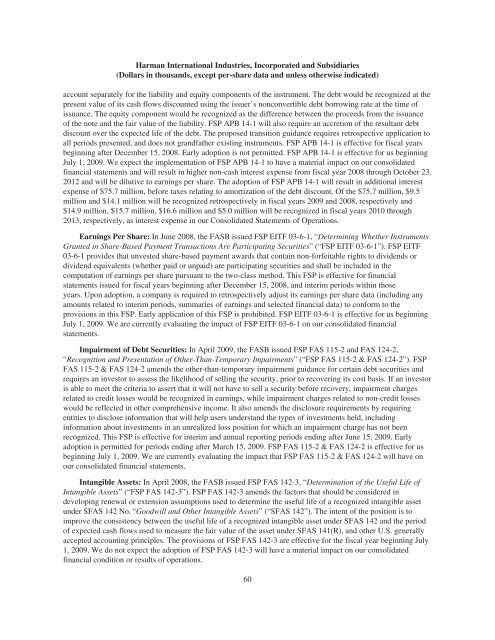Create successful ePaper yourself
Turn your PDF publications into a flip-book with our unique Google optimized e-Paper software.
<strong>Harman</strong> International Industries, Incorporated and Subsidiaries<br />
(Dollars in thousands, except per-share data and unless otherwise indicated)<br />
account separately for the liability and equity components of the instrument. The debt would be recognized at the<br />
present value of its cash flows discounted using the issuer’s nonconvertible debt borrowing rate at the time of<br />
issuance. The equity component would be recognized as the difference between the proceeds from the issuance<br />
of the note and the fair value of the liability. FSP APB 14-1 will also require an accretion of the resultant debt<br />
discount over the expected life of the debt. The proposed transition guidance requires retrospective application to<br />
all periods presented, and does not grandfather existing instruments. FSP APB 14-1 is effective for fiscal years<br />
beginning after December 15, 2008. Early adoption is not permitted. FSP APB 14-1 is effective for us beginning<br />
July 1, 2009. We expect the implementation of FSP APB 14-1 to have a material impact on our consolidated<br />
financial statements and will result in higher non-cash interest expense from fiscal year 2008 through October 23,<br />
2012 and will be dilutive to earnings per share. The adoption of FSP APB 14-1 will result in additional interest<br />
expense of $75.7 million, before taxes relating to amortization of the debt discount. Of the $75.7 million, $9.5<br />
million and $14.1 million will be recognized retrospectively in fiscal years 2009 and 2008, respectively and<br />
$14.9 million, $15.7 million, $16.6 million and $5.0 million will be recognized in fiscal years 20<strong>10</strong> through<br />
2013, respectively, as interest expense in our Consolidated Statements of Operations.<br />
Earnings Per Share: In June 2008, the FASB issued FSP EITF 03-6-1, “Determining Whether Instruments<br />
Granted in Share-Based Payment Transactions Are Participating Securities” (“FSP EITF 03-6-1”). FSP EITF<br />
03-6-1 provides that unvested share-based payment awards that contain non-forfeitable rights to dividends or<br />
dividend equivalents (whether paid or unpaid) are participating securities and shall be included in the<br />
computation of earnings per share pursuant to the two-class method. This FSP is effective for financial<br />
statements issued for fiscal years beginning after December 15, 2008, and interim periods within those<br />
years. Upon adoption, a company is required to retrospectively adjust its earnings per share data (including any<br />
amounts related to interim periods, summaries of earnings and selected financial data) to conform to the<br />
provisions in this FSP. Early application of this FSP is prohibited. FSP EITF 03-6-1 is effective for us beginning<br />
July 1, 2009. We are currently evaluating the impact of FSP EITF 03-6-1 on our consolidated financial<br />
statements.<br />
Impairment of Debt Securities: In April 2009, the FASB issued FSP FAS 115-2 and FAS 124-2,<br />
“Recognition and Presentation of Other-Than-Temporary Impairments” (“FSP FAS 115-2 & FAS 124-2”). FSP<br />
FAS 115-2 & FAS 124-2 amends the other-than-temporary impairment guidance for certain debt securities and<br />
requires an investor to assess the likelihood of selling the security, prior to recovering its cost basis. If an investor<br />
is able to meet the criteria to assert that it will not have to sell a security before recovery, impairment charges<br />
related to credit losses would be recognized in earnings, while impairment charges related to non-credit losses<br />
would be reflected in other comprehensive income. It also amends the disclosure requirements by requiring<br />
entities to disclose information that will help users understand the types of investments held, including<br />
information about investments in an unrealized loss position for which an impairment charge has not been<br />
recognized. This FSP is effective for interim and annual reporting periods ending after June 15, 2009. Early<br />
adoption is permitted for periods ending after March 15, 2009. FSP FAS 115-2 & FAS 124-2 is effective for us<br />
beginning July 1, 2009. We are currently evaluating the impact that FSP FAS 115-2 & FAS 124-2 will have on<br />
our consolidated financial statements.<br />
Intangible Assets: In April 2008, the FASB issued FSP FAS 142-3, “Determination of the Useful Life of<br />
Intangible Assets” (“FSP FAS 142-3”). FSP FAS 142-3 amends the factors that should be considered in<br />
developing renewal or extension assumptions used to determine the useful life of a recognized intangible asset<br />
under SFAS 142 No. “Goodwill and Other Intangible Assets” (“SFAS 142”). The intent of the position is to<br />
improve the consistency between the useful life of a recognized intangible asset under SFAS 142 and the period<br />
of expected cash flows used to measure the fair value of the asset under SFAS 141(R), and other U.S. generally<br />
accepted accounting principles. The provisions of FSP FAS 142-3 are effective for the fiscal year beginning July<br />
1, 2009. We do not expect the adoption of FSP FAS 142-3 will have a material impact on our consolidated<br />
financial condition or results of operations.<br />
60





